You’ve probably noticed your smart TV doing more than just streaming shows lately. It’s quietly becoming the command center of your home, connecting everything from your lights to your security system through a single, familiar screen. What you might not realize is how this shift transforms the way you’ll interact with your entire living space, creating possibilities that go far beyond traditional entertainment.
Smart TVs as IoT Devices in Modern Homes

As smart home technology continues to evolve, your TV has transformed from a simple entertainment device into a sophisticated IoT hub that orchestrates your entire connected home ecosystem.
Modern smart TVs integrate seamlessly with home automation systems, allowing you to control lighting, security cameras, thermostats, and other IoT devices directly from your television interface. This central hub capability eliminates the need for multiple control apps or devices, streamlining your smart home management.
Smart TVs now serve as comprehensive command centers, consolidating control of your entire connected home ecosystem into one intuitive interface.
With built-in voice control through Amazon Alexa or Google Assistant, you can command your connected devices hands-free while watching your favorite shows.
Your smart TV’s internet connectivity enables real-time communication between devices, creating a cohesive network that responds intelligently to your preferences and daily routines.
Voice Assistant Integration for Seamless Control
Three simple words can now control your entire entertainment and home automation experience through voice assistant integration in smart TVs.
You’ll find Amazon Alexa, Google Assistant, or Apple Siri seamlessly built into modern smart TVs, creating central control for your entire connected ecosystem.
Voice assistants enable hands-free operation of TV functions like volume adjustment, channel selection, and content searches without maneuvering through menus manually.
You can simultaneously manage smart home devices including lights and thermostats directly through your TV using simple voice commands.
This integration supports customized automation routines like “Movie Night,” which adjusts lighting and sound settings simultaneously.
Your smart TV becomes the command center, eliminating multiple remotes and apps while streamlining control of your entertainment and home automation systems through natural speech.
Unified Control Interface for Multiple Smart Devices
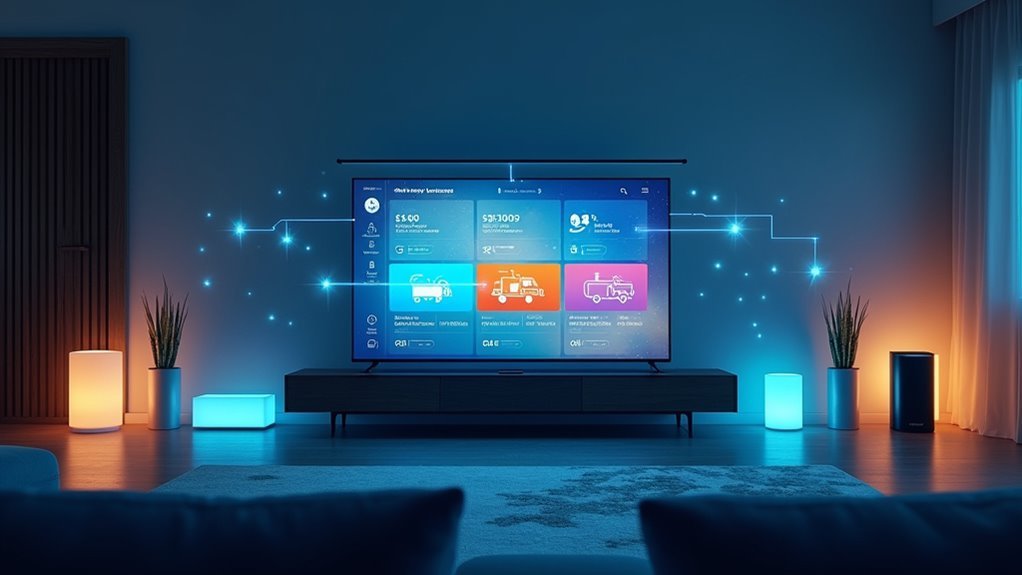
When you consolidate control of your smart home ecosystem through your TV’s unified control interface, you’ll eliminate the frustration of juggling multiple apps and remotes.
This centralized approach transforms your television into the command center for all connected devices, from security cameras to thermostats and lighting systems.
Your TV’s interface displays real-time status updates for every smart device in your home automation network. You can monitor security feeds, adjust climate settings, and control appliances without switching between different platforms.
Monitor every connected device from one central dashboard, tracking security feeds and climate controls without the hassle of switching apps.
The integration extends beyond manual control—voice assistants enable hands-free management through simple commands.
Create customized routines like “Movie Mode” that simultaneously dims lights and optimizes sound settings.
This seamless coordination between smart devices through your TV’s unified interface makes home automation truly effortless and intuitive.
Compatibility With Major Smart Home Platforms
Today’s smart TVs integrate effortlessly with the three dominant smart home ecosystems: Google Home, Amazon Alexa, and Apple HomeKit.
Smart TVs offer extensive compatibility that transforms your television into a central hub for home automation management. You’ll find seamless synchronization with Google-certified devices, while voice assistants like Amazon Alexa enable hands-free control through Fire TVs.
Apple HomeKit support lets you manage lighting, security systems, and other compatible devices directly from your TV interface.
This broad platform compatibility means you won’t be locked into a single ecosystem. You can control various smart home devices from one unified screen, eliminating the need for multiple apps or remotes.
Your smart TV becomes the command center that enhances your home automation capabilities across all major platforms.
Central Hub Functionality for Home Automation
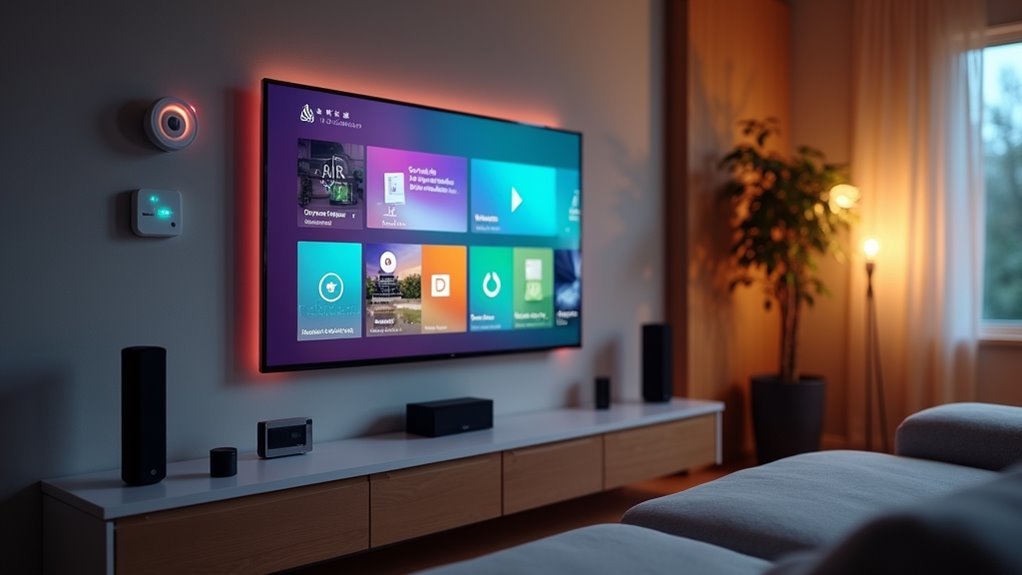
You can transform your smart TV into a powerful central hub that controls all your connected home devices through one streamlined interface.
Voice assistant integration lets you manage everything hands-free, from adjusting your thermostat to dimming lights with simple spoken commands.
The TV’s automation routine management enables you to create custom scenarios like “Movie Mode” that simultaneously optimizes multiple devices for the perfect entertainment experience.
Unified Device Control Interface
How can you manage dozens of smart home devices without juggling multiple apps and remotes? Your smart TV’s unified control interface eliminates this complexity by serving as a thorough Smart Home Hub.
You’ll find everything you need on one screen – from adjusting your thermostat to dimming lights and checking security cameras. The intuitive on-screen interface makes control effortless, letting you navigate between interconnected devices seamlessly.
Voice commands through built-in assistants add another layer of convenience, allowing hands-free management of your entire ecosystem. You can even create custom automation routines like “Movie Night” that simultaneously dims lights, adjusts temperature, and optimizes audio settings with a single command, streamlining your daily interactions with technology.
Voice Assistant Integration
Voice assistant integration transforms your smart TV into the command center of your home automation ecosystem. When you connect popular voice assistants like Amazon Alexa, Google Assistant, or Apple Siri to your TV, you gain hands-free control over multiple smart home devices from one central hub.
You can adjust lighting, modify thermostat settings, and manage security systems using simple voice commands without switching between separate apps or remotes. Your TV displays real-time security camera feeds while enabling direct interaction with your entire home automation network.
The most powerful feature is triggering extensive routines like “Movie Mode,” where a single voice command simultaneously dims lights, adjusts temperature, and optimizes your entertainment settings, creating seamless automation experiences throughout your home.
Automation Routine Management
Three essential components make automation routine management the cornerstone of modern smart TV functionality: centralized device control, customizable trigger sequences, and real-time status monitoring.
Smart TVs transform your living room into a command center where you’ll manage all connected smart devices through one intuitive interface. You can program sophisticated automation routines that respond to specific triggers, streamlining your daily tasks effortlessly. Voice commands activate complex sequences instantly, whether you’re dimming lights for movie night or initiating your morning routine.
- Create multi-device automation sequences that activate simultaneously with single commands
- Monitor real-time status updates from security cameras, thermostats, and lighting systems
- Schedule recurring routines for ideal energy management and convenience
- Customize trigger conditions based on time, location, or specific device states
- Integrate seamlessly with existing smart home platforms for enhanced home management
Real-Time Monitoring and Security Camera Feeds
Your smart TV transforms into an extensive security command center when you integrate it with your home’s camera system.
You’ll receive instant security alerts and notifications directly on your TV screen, eliminating the need to constantly check your phone or dedicated monitoring devices.
The ability to display live feeds from multiple cameras simultaneously gives you complete visibility of your property’s security status at a glance.
Live Camera Display Integration
While traditional security monitoring required multiple screens or mobile devices, modern smart TVs transform your living room into an all-encompassing surveillance command center.
Your smart home integration enables seamless live camera feeds directly on your centralized screen, eliminating the need for additional hardware. You’ll respond faster to potential threats since everything displays on one primary interface.
Key features of live camera display integration include:
- Multiple camera feeds switching between different property locations and angles
- Real-time surveillance footage access for immediate threat assessment
- Voice control capabilities allowing hands-free camera view requests
- Smart home platform compatibility creating cohesive ecosystem management
- Enhanced home security through instant visual monitoring from your couch
This integration streamlines your security management while maintaining ideal convenience and control.
Security Alert Notifications
Since modern smart TVs integrate seamlessly with home security systems, you’ll receive instant alert notifications that transform your entertainment screen into a critical safety monitor.
When your security cameras detect unusual activity or breaches, notifications appear directly on your TV, ensuring you’re immediately aware of potential threats. You can customize these alerts based on priority levels, choosing which events trigger immediate interruptions versus background notifications.
Smart TVs excel in home automation by centralizing your security monitoring experience. Voice commands let you instantly access camera feeds during emergencies, while the large display provides clear visibility of critical information.
This integration streamlines your security management, making your television an essential component of thorough home protection.
Multi-Camera View Management
How effectively can you monitor your entire property from one convenient location?
Smart TVs excel at multi-camera viewing, transforming your living room into a thorough security command center. Through smart home security integration, you’ll access all security camera feeds simultaneously on one large screen, eliminating the need for multiple devices or small smartphone displays.
Your TV’s real-time monitoring capabilities let you switch between camera angles effortlessly and monitor different zones throughout your property.
Voice control capabilities streamline the experience further—simply ask to view specific cameras or check your system’s status.
Key multi-camera management features include:
- Simultaneous display of multiple security feeds on split screens
- Easy switching between individual camera views and zone monitoring
- Motion detection alerts displayed directly on your TV
- Voice-activated camera selection and security status checks
- Seamless integration with existing smart home security systems
Automated Routines and Scene Management
When you start a movie on your smart TV, you can trigger automated routines that transform your entire living space without lifting a finger. Your TV becomes the catalyst for thorough scene management, automatically dimming lights and adjusting your thermostat for ideal viewing comfort.
You’ll love creating customized scenes like “Movie Night” that control multiple devices with a single command, making guest entertainment effortless. Voice-controlled systems let you initiate these routines hands-free, eliminating the need to juggle multiple apps or remotes.
Your smart TV doubles as a centralized control hub, displaying real-time status updates for connected devices including lights and security systems.
Through integration with smart home hubs, your TV orchestrates complex sequences involving various devices, ensuring your environment perfectly matches specific activities or times of day.
Energy Efficiency Through Smart Device Coordination
When you integrate your smart TV with your home’s automated power management systems, you’ll create an energy-efficient ecosystem that responds intelligently to your viewing habits.
Your TV can now communicate with smart thermostats to adjust heating and cooling based on room occupancy and usage patterns, reducing unnecessary energy consumption.
Through coordinated device scheduling, you’ll establish routines that synchronize your TV with lighting, climate control, and other smart devices to optimize energy usage throughout your home.
Automated Power Management Systems
While energy costs continue rising, automated power management systems offer a sophisticated solution by coordinating your smart TV with other connected devices to optimize household energy consumption.
These systems use smart home technology to analyze usage patterns and occupancy, automatically adjusting settings across your connected devices. Your central smart hub orchestrates energy-saving routines, while voice-controlled automation through your smart TV lets you manage power settings effortlessly.
This coordination can reduce your electricity bills by up to 30%.
- Track real-time energy consumption through integrated smart plugs and monitors
- Create customized scenarios like “Movie Night” that optimize lighting and power settings
- Schedule automatic device shutdowns during peak energy hours
- Monitor occupancy patterns to turn off devices when rooms are empty
- Coordinate multiple devices simultaneously for maximum efficiency
Smart Thermostat TV Integration
Smart thermostat TV integration transforms your entertainment center into a thorough climate control hub, allowing you to adjust home temperatures directly from your TV interface or through simple voice commands.
This seamless integration enhances your user experience while delivering substantial energy savings through intelligent coordination between devices.
You can create automated routines like “Movie Night” that simultaneously adjust your thermostat to ideal comfort levels while dimming lights.
Your TV receives real-time data from smart thermostats, enabling remote monitoring of energy usage through a unified control interface.
This home automation approach maximizes consumption based on your viewing habits—automatically lowering temperatures when movies start.
Studies demonstrate that automated temperature adjustments can reduce heating and cooling costs by 10-30% annually, making smart thermostat integration both convenient and cost-effective.
Coordinated Device Scheduling
Beyond simple device control, coordinated scheduling creates an intelligent ecosystem where your TV orchestrates energy management across your entire home.
Smart TVs integrate seamlessly with smart home devices through automation hubs, triggering energy-saving routines automatically. When you start watching, your TV can dim lights, adjust thermostats, and optimize energy consumption without manual intervention.
- Automated lighting adjustment – Lights automatically dim during movie nights to reduce energy waste
- Thermostat coordination – Heating adjusts based on your viewing schedule patterns
- Peak-hour scheduling – Smart assistants schedule TV operation during off-peak energy times
- Real-time usage feedback – Monitor energy consumption to identify optimization opportunities
- Intelligent routine triggers – TV usage activates extensive energy management protocols
This coordinated device scheduling transforms your entertainment center into an energy efficiency command hub.
Multi-Screen Functionality and Content Sharing
As entertainment needs evolve beyond single-device viewing, multi-screen functionality transforms how you interact with your smart TV by enabling seamless mirroring of content from smartphones, tablets, and laptops directly to the big screen.
This capability enhances your entertainment systems by supporting split-screen and picture-in-picture modes, allowing you to multitask effectively while watching shows or movies.
Multi-screen functionality revolutionizes entertainment by enabling split-screen and picture-in-picture modes for seamless multitasking during viewing sessions.
You’ll find content sharing particularly valuable during gatherings, as guests can easily display photos, videos, or presentations.
The integration with streaming devices creates opportunities for productivity enhancement, letting you browse the web or work on documents simultaneously.
When your smart TVs coordinate with other smart home devices, they establish a cohesive entertainment environment that optimizes collaboration and sharing experiences throughout your connected home ecosystem.
Gaming Platform Integration With Smart Home Features
When you connect your gaming console to your smart TV, you’re not just accessing entertainment—you’re opening a centralized command center that bridges your gaming experience with your entire smart home ecosystem.
Your smart TV transforms into an interactive gaming hub that seamlessly integrates with cloud gaming services while delivering high-definition graphics.
Through voice control features, you’ll manage smart home devices directly from your gaming session—adjusting lighting or temperature without pausing gameplay.
Screen mirroring capabilities let you share content from mobile devices, creating collaborative gaming experiences.
Key gaming integration features include:
- Multiple HDMI and USB ports for easy peripheral connections
- Voice commands for controlling smart home devices during gameplay
- Screen mirroring for sharing mobile content and gameplay
- Customizable gaming routines through home automation systems
- Seamless switching between gaming consoles and entertainment options
Streaming Service Access and Entertainment Control
Your smart TV eliminates the clutter of external streaming devices by providing direct access to Netflix, Amazon Prime Video, Hulu, and dozens of other platforms through a single, intuitive interface.
Built-in Wi-Fi connectivity guarantees seamless streaming without additional cables or complications.
Voice control features transform your entertainment experience, letting you search for content, adjust volume, and switch between apps hands-free.
You’ll discover new shows effortlessly through personalized recommendations that adapt to your viewing preferences.
Beyond streaming, your smart TV becomes a central control hub for connected home devices.
You can adjust lighting, manage thermostats, and monitor security systems directly from your screen.
This integration creates a unified entertainment and automation experience, making your TV the command center for both digital content and smart home management.
Device Discovery and Smart Home Network Management
Your smart TV automatically scans your home network to identify and catalog compatible devices, from smart bulbs to security cameras.
It creates a visual map of your network topology, showing you how all your devices connect and communicate with each other.
This automatic recognition eliminates the tedious process of manually searching for and adding each smart home component to your system.
Automatic Device Recognition
As smart home ecosystems become increasingly complex, automatic device recognition emerges as an essential feature that transforms your TV into an intelligent hub capable of discovering and connecting with compatible devices across your network.
This technology eliminates tedious manual configuration by utilizing protocols like Universal Plug and Play (UPnP) and Simple Service Discovery Protocol (SSDP) to identify interconnected devices automatically.
Your smart home benefits from this seamless integration through:
- Unified control interface – Manage lighting, thermostats, and security systems directly from your TV
- Real-time device updates – Automatically refreshes device lists when new compatible equipment joins the network
- Simplified setup process – Eliminates complex configuration steps for enhanced device discovery
- Centralized management – Your TV becomes the central hub for all smart home operations
- Improved user experience – Reduces setup time while providing instant access to connected devices
Network Topology Mapping
Building on automatic device recognition capabilities, network topology mapping creates a detailed visual blueprint of your smart home’s interconnected ecosystem. Your smart TVs utilize device discovery protocols like UPnP to identify and map every connected device, from thermostats to security cameras.
| Network Component | Function |
|---|---|
| Device Discovery | Identifies all smart home devices automatically |
| Topology Mapping | Creates visual network structure representation |
| Hub Management | Enables centralized device control |
| Performance Monitoring | Tracks connection quality and efficiency |
This mapping process transforms your TV into a central hub that understands your entire network structure. Through mesh networking technology, smart TVs maintain strong connectivity while eliminating dead zones. You’ll benefit from seamless communication between devices and optimized network management that continuously monitors connections for peak performance.
Personalized User Experience Through Data Analytics
When you turn on your smart TV, sophisticated data analytics engines immediately begin tracking your viewing habits to create a uniquely tailored entertainment experience.
Your TV analyzes every interaction to understand your preferences, delivering personalized content recommendations that match your tastes perfectly.
This data-driven approach transforms your user experience by suggesting shows and movies based on previously watched content.
You’ll receive insights about your viewing patterns, helping you make informed entertainment choices.
Integration with smart home devices creates seamless automation scenarios.
- Personalized show and movie recommendations based on viewing history
- Smart notifications and reminders for favorite series premieres
- Automated lighting and temperature adjustments during specific content types
- Detailed analytics reports showing your consumption patterns
- Cross-platform content discovery connecting multiple streaming services
Future Innovations in Smart TV Home Automation
The next generation of smart TV technology will revolutionize how you control and interact with your entire smart home ecosystem.
You’ll experience unprecedented personalization as AI analyzes your viewing habits to deliver tailored content recommendations. Enhanced 8K resolution will provide stunning visual clarity and vibrant colors for immersive entertainment.
Your smart TVs will seamlessly connect with expanding IoT devices, creating a centralized home automation control hub.
Smart TVs evolve beyond entertainment into powerful command centers that unify your entire connected home ecosystem under one intuitive interface.
Advanced voice recognition technology will enable sophisticated natural language processing, letting you manage home automation tasks hands-free through simple conversations.
Energy efficiency innovations will help you monitor and optimize power consumption across all connected devices.
This centralized approach not only streamlines your smart home management but also supports sustainability efforts by reducing overall energy waste throughout your automated home environment.
Frequently Asked Questions
What Qualifies a TV to Be a Smart TV?
You’ll qualify your TV as smart when it connects to the internet, runs streaming apps like Netflix, responds to voice commands, and integrates with other smart home devices for centralized control.
What Is the Difference Between Smart Home and Home Automation?
You’ll find smart home technology includes all remotely controlled devices, while home automation specifically focuses on automated processes. Smart homes can involve manual app control, but automation runs programmed routines without your intervention.
What Is the Downside of a Smart TV?
You’ll face privacy risks from data collection, security vulnerabilities from outdated software, compatibility issues with other devices, frequent maintenance requirements, and higher costs including both purchase price and ongoing subscription fees.
How Can I Tell if My TV Is Smart?
You’ll know your TV’s smart if it connects to Wi-Fi, has pre-installed streaming apps like Netflix, includes voice control features, supports screen mirroring from phones, and offers downloadable apps through an interface.

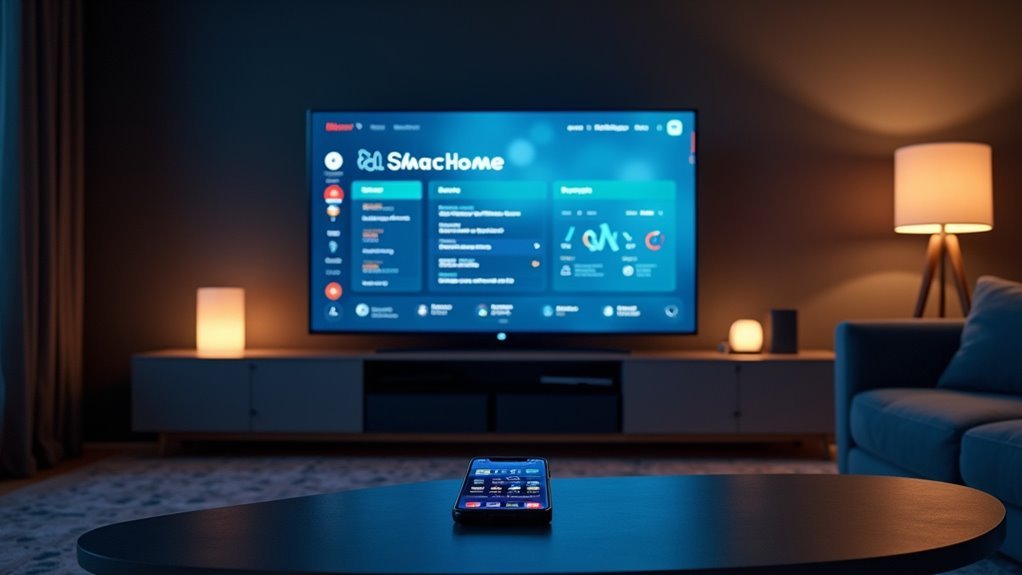

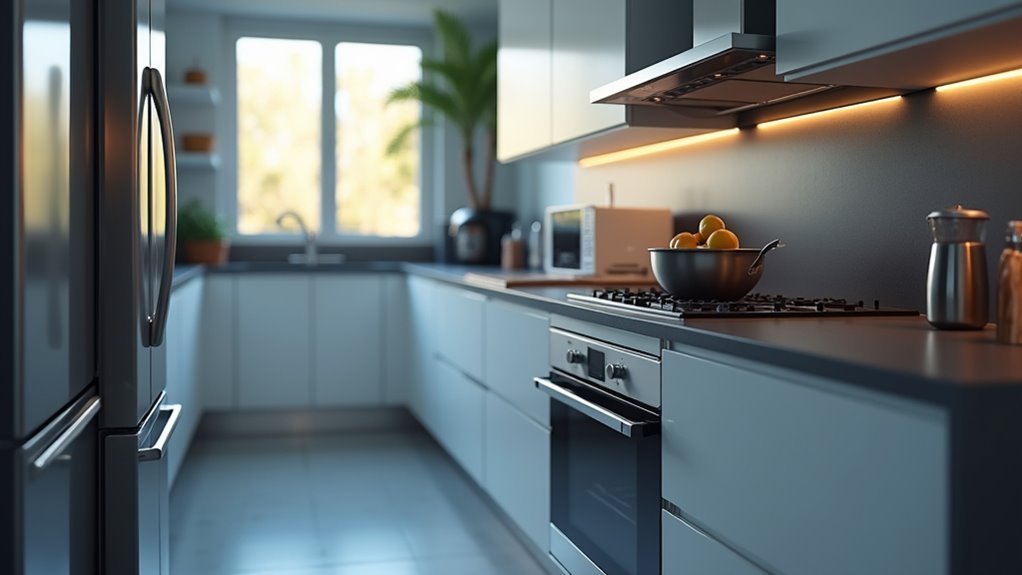
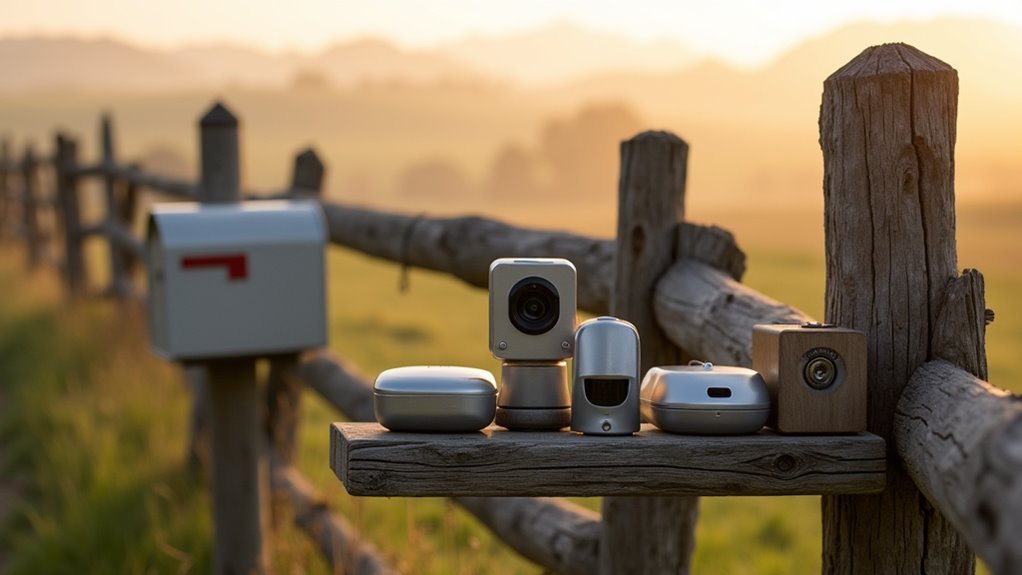
Leave a Reply